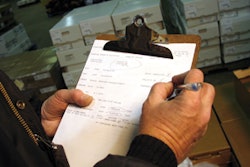EDITOR'S NOTE: Since APL Logistics launched a formal safety initiative in 1995, its rate of OSHA-recordable incidents has dropped 88 percent-to 71 percent below the industry average.
According to Marty Gordon, company'director of risk management in the Americas, APL Logistics has been able to effect safety improvements from day one of the program. However some of the most dramatic results-a 50 percent reduction in injuries and a 56 percent reduction in workers' compensation claims expenses-have occurred since 2004.
Given that success, Food Logistics asked Gordon to share some helpful hints about how a company can keep its safety momentum going strong-and even make it stronger-even when it's no longer new and different.
Tie it in with your worker's comp: Some people regard worker's compensation claims as a catalogue of safety lapses-the accidents that might have been prevented under different circumstances.
However these claims are also a potential treasure trove of information for your safety personnel. Their data can be instrumental in pointing out weak areas of your current safety program-by identifying what currently are your company's most common causes of injury-so you can tweak or beef it up accordingly. The data is equally helpful in identifying locations with the highest frequency of losses, so safety efforts and resources can be appropriately focused.
Watch your employees' backs (and necks and . . .): Ergonomic injuries such as strained backs or necks represent one of the largest threats to your warehouse employees' health and comfort.
They also represent a threat to your company's bottom line.
For these reasons and many more, adding ergonomic awareness training to your safety initiative is a win-win situation for everyone.
In addition to helping your employees avoid seriously uncomfortable ergonomic injuries, having such a program ends a powerful message that your company is truly exploring employee safety from all angles, and that it will leave no stone unturned in protecting its personnel.
Vary your communications: People have many different learning styles-which is why you can't expect a one-channel, single-style safety effort to be successful with everyone.
By using a combination of everything from classroom instruction and manuals to videos, e-mails and visual displays you'll give your messages a greater chance of hitting home with all of your employee audience.
This is especially true as your safety effort matures, because a diverse communications approach enables you to mix things up and re-communicate some of your most important safety policies or tips without seeming repetitive.
Aim for different levels: Facility managers may be the primary conduit of communication between an organization and its DC employees-especially when it comes to scheduling safety classes at individual facilities. But their buy-in alone is not enough to sustain a successful safety initiative. For one thing, they're very busy people with many other jobs to do. For another, they're not your company's only key influencers.
Make sure you're grooming safety advocates at all levels of your organization-from supervisors and floor leaders all the way up to regional vice presidents and boardroom members-because you cannot have too many people working to reduce risk.
Above all, aim to create the kind of corporate culture where safety isn't considered to be just the job of the safety department. To be effective, all employees must be aware that one of their primary functional responsibilities is to ensure that they and their co-workers are able to return to their families at the end of the day in the same condition they arrived at work. A safety professional's job is to be a resource to them in meeting this objective. But everyone has to view it as a component of their job rather than a standalone function.
Be a class act-and share the load: It's important to hold periodic safety classes throughout your DC network, even if you feel like you've taught at certain facilities so often they should give you your own personalized parking space. With industry turnover being what it is, there will always be a number of new employees who missed the initial sessions. Plus even the best students occasionally need to be re-educated, especially when it comes to the "big" subjects like forklift safety.
But bear in mind that your safety professionals aren't the only ones who can teach. With the right materials in hand-and the proper training – many managers, supervisors or employees can make great instructors. We've had a lot of successful "train the trainer" classes in recent years and not only has it helped us get our employees educated more quickly, it's also created a vast number of additional safety champions.
Nor do you have to rely only on company-developed materials. Our workers compensation insurer has been more than helpful about developing some wonderful training courses on forklift safety and ergonomics. And many equipment manufacturers offer great courses on operating their equipment that you can modify for your needs.
Reinforce: Contrary to what you might think, quality safety instruction doesn't begin and end in the classroom. Your organization should be engaged in safety education even when "school" isn't in session.
New employees should always receive safety instruction-as should any temps, because even if the temp agency has a reputation for providing safety training, chances are there are some safety tips they may not communicate as well as you would.
Members of your organization also should get safety education in the form of newsletters, e-mails and safety tips at employee meetings.
And don't underestimate the importance of "sign language," because traffic signals and warning signs aren't just for the great outdoors. They're an easy and inexpensive way to remind employees to avoid risky behaviors right in the context where these behaviors occur. Plus they're always on duty and they don't charge overtime.
Correct: Safety is by and large a positive concept.
However, there are times when a negative, "don't let this happen to you" approach is merited.
Every time one of your employees has an accident or injury-and even employees in "safe" organizations do-it's an important learning and teaching opportunity.
By reviewing what happened, your organization can determine if there was an unsafe process involved and take steps to correct it. And by reviewing incidents with your employees in a "here's what happened and why" fashion, you can make the issue of safety real to them in a way that hypothetical situations can't. This kind of candor is one of the most powerful tools a safety-minded company has, because if you're serious about creating a safer environment, you have to be willing to talk about your failures as well as your successes. Otherwise it's just too easy for people to get too complacent about safety-and sometimes that complacency can turn into the carelessness that leads to accidents.
Let employees know you mean business: Many areas of employee performance can be negotiable. Safety isn't one of them.
All of your employees need to know that while accidents do happen, deliberate breaches of safety won't be tolerated-and that any of these breaches will have definitive consequences such as suspension or even termination.
Just as important, they need to see you make good on this safety promise each and every time a violation occurs.
I know this sounds hard-hearted. But it's actually one of the most humane policies a company can have, because by practicing zero-tolerance for unsafe behavior, you could be preventing an employee from doing something dangerous that changes their life forever. Just as important, you're protecting your other employees from being hurt too.
Create Incentives
Ideally, your managers, supervisors and employees should want to be safe because it's the right thing to do. But in the words of that unforgettable Jerry McGuire movie, they'll be even more inclined to actively pursue safer conditions if you "show them the money."
By tying executives' and managers' compensation into safety numbers such as percentage of OSHA-recordable incidents, you'll motivate them to hold the people below them more accountable for minimizing unsafe behaviors. And by offering even small potential financial rewards to employees at locations that maintain a safe record, you'll do wonders in terms of getting them on the bandwagon.
Some of our facilities have a safety bingo game where a certain amount of money is contributed to the pot for each day that employees are accident-free. At the end of a certain period, they draw a name, and that person wins the pot. The catch is the pot returns to zero each time there's an injury-and no one wants to be the one that zeroes things out.
Stay the course: On a final note, allow me to say that one of the best ways for an organization to keep safety momentum going is to continue funding an active safety initiative-even if your company's employees haven't had many major incidents or injuries in recent years.
No matter how mature your safety effort is-or how safety-conscious your employees are-nothing changes the fact that the shipping profession has more than its fair share of hazards and risks.
If your logistics program has been accident-free for a long time, don't automatically assume it means you don't need a safety program. You may have been lucky rather than safe.
As long as you have human beings working in the warehouse, there will always be room for error-and a need for safety vigilance. d














